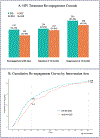Using Data-To-Care Strategies to Optimize the HIV Care Continuum in Connecticut: Results From a Randomized Controlled Trial
- PMID: 38324241
- PMCID: PMC11009056
- DOI: 10.1097/QAI.0000000000003391
Using Data-To-Care Strategies to Optimize the HIV Care Continuum in Connecticut: Results From a Randomized Controlled Trial
Abstract
Background: Re-engaging people with HIV who are newly out-of-care remains challenging. Data-to-care (D2C) is a potential strategy to re-engage such individuals.
Methods: A prospective randomized controlled trial compared a D2C strategy using a disease intervention specialist (DIS) vs standard of care where 23 HIV clinics in 3 counties in Connecticut could re-engage clients using existing methods. Using a data reconciliation process to confirm being newly out-of-care, 655 participants were randomized to DIS (N = 333) or standard of care (N = 322). HIV care continuum outcomes included re-engagement at 90 days, retention in care, and viral suppression by 12 months. Multivariable regression models were used to assess factors predictive of attaining HIV care continuum outcomes.
Results: Participants randomized to DIS were more likely to be re-engaged at 90 days (adjusted odds ratios [aOR] = 1.42, P = 0.045). Independent predictors of re-engagement at 90 days were age older than 40 years (aOR = 1.84, P = 0.012) and perinatal HIV risk category (aOR = 3.19, P = 0.030). Predictors of retention at 12 months included re-engagement at 90 days (aOR = 10.31, P < 0.001), drug injection HIV risk category (aOR = 1.83, P = 0.032), detectable HIV-1 RNA before randomization (aOR = 0.40, P = 0.003), and county (Hartford aOR = 1.74, P = 0.049; New Haven aOR = 1.80, P = 0.030). Predictors of viral suppression included re-engagement at 90 days (aOR = 2.85, P < 0.001), retention in HIV care (aOR = 7.07, P < 0.001), and detectable HIV-1 RNA prerandomization (aOR = 0.23, P < 0.001).
Conclusions: A D2C strategy significantly improved re-engagement at 90 days. Early re-engagement improved downstream benefits along the HIV care continuum like retention in care and viral suppression at 12 months. Moreover, other factors predictive of care continuum outcomes can be used to improve D2C strategies.
Trial registration: ClinicalTrials.gov NCT02693145.
Copyright © 2024 Wolters Kluwer Health, Inc. All rights reserved.
Conflict of interest statement
The authors have no funding or conflicts of interest to disclose.
Figures

Similar articles
-
Predictors of Successful HIV Care Re-engagement Among Persons Poorly Engaged in HIV Care.AIDS Behav. 2019 Sep;23(9):2490-2497. doi: 10.1007/s10461-019-02491-y. AIDS Behav. 2019. PMID: 30980279
-
Advancing data to care strategies for persons with HIV using an innovative reconciliation process.PLoS One. 2022 May 5;17(5):e0267903. doi: 10.1371/journal.pone.0267903. eCollection 2022. PLoS One. 2022. PMID: 35511958 Free PMC article. Clinical Trial.
-
The Cooperative Re-Engagement Controlled trial (CoRECT): A randomised trial to assess a collaborative data to care model to improve HIV care continuum outcomes.Lancet Reg Health Am. 2021 Aug 28;3:100057. doi: 10.1016/j.lana.2021.100057. eCollection 2021 Nov. Lancet Reg Health Am. 2021. PMID: 36777404 Free PMC article.
-
Using the exploration, preparation, implementation, sustainment (EPIS) framework to assess the cooperative re-engagement controlled trial (CoRECT).Front Public Health. 2023 Dec 1;11:1223149. doi: 10.3389/fpubh.2023.1223149. eCollection 2023. Front Public Health. 2023. PMID: 38106893 Free PMC article. Review.
-
Care continuum entry interventions: seek and test strategies to engage persons most impacted by HIV within the United States.AIDS. 2018 Feb 20;32(4):407-417. doi: 10.1097/QAD.0000000000001733. AIDS. 2018. PMID: 29381558 Free PMC article. Review.
Cited by
-
Disease Intervention Specialist Field Experience in Re-engaging Out-of-Care People with HIV in Project CoRECT: A Mixed Methods Study.AIDS Behav. 2025 Aug;29(8):2451-2460. doi: 10.1007/s10461-025-04707-w. Epub 2025 Apr 10. AIDS Behav. 2025. PMID: 40205311 Clinical Trial.
References
-
- Ending the HIV Epidemic in the U.S. (EHE) Pillars. 17 Sep, 2023. https://www.cdc.gov/endhiv/about-ehe/pillars.html
-
- CDC. Monitoring Selected National HIV Prevention and Care Objectives by Using HIV Surveillance Data—United States and 6 Dependent Areas, 2021: National Profile. https://www.cdc.gov/hiv/library/reports/hiv-surveillance/vol-28-no-4/con...
-
- Fast-Track—Ending the AIDS epidemic by 2030. UNAIDS. 2014;
Publication types
MeSH terms
Substances
Associated data
Grants and funding
LinkOut - more resources
Full Text Sources
Medical

